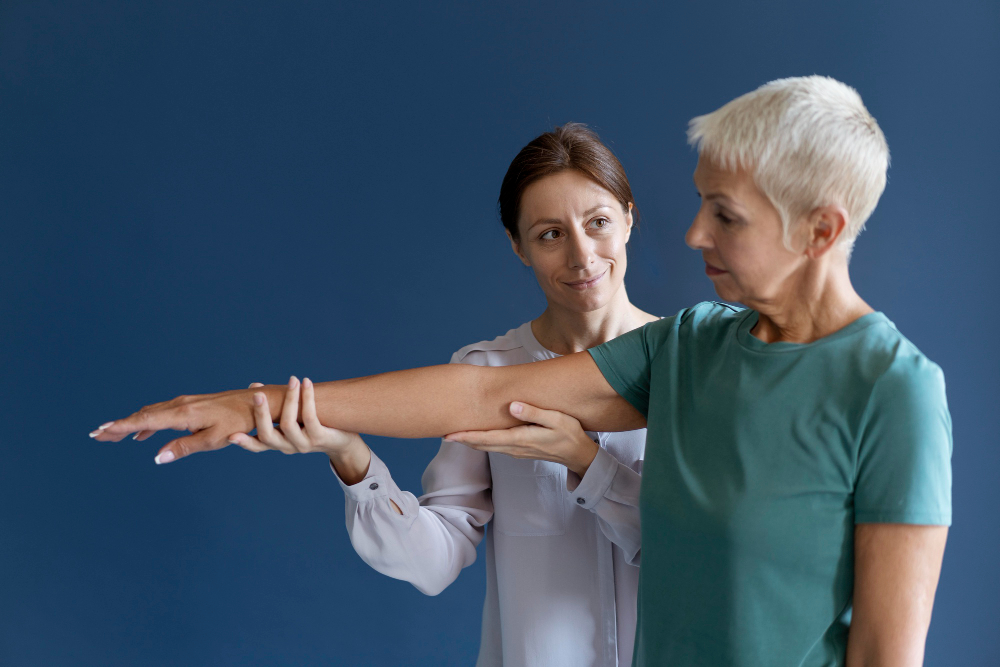Arthritis is a severely painful condition that can hamper a person’s way of life. Corticosteroid injections for knee pain and arthritis are an excellent way to reduce the pain and inflammation.
Arthritis can occur in almost all age groups.
A few statistics will help elaborate on how widespread the condition is:
- 20 million people in the UK suffer from Musculoskeletal conditions
- 28 million working days are lost each year
- Around 1% of the UK population suffers from Rheumatoid arthritis
- The number of people suffering from rheumatoid arthritis is fairly high at 450000
- Arthritis is 2 – 4 times more common in women than men.
This data has been further supplemented by a 2020 study by NICE (National Institute for Healthcare and Excellence).
What is Arthritis?
Arthritis is a fairly common condition that causes joint inflammation and severe pain. While more commonly seen in the elderly, arthritis can affect anyone irrespective of their age.
The commonest forms of arthritis are:
● Osteoarthritis
This is the commonest form of arthritis. This occurs when joint tissue damage is greater or more rapid than the body’s ability to replace damaged tissue. As the damage builds up, the protective cartilage wears down, causing the ends of the bones in a joint to rub against each other.
This can be caused by an unusual and sustained stress on the knees, brought on by age, injuries, and repetitive stress on a joint. Weight gain is also a significant risk factor, as are genetics.
The knees are particularly susceptible to osteoarthritis. This condition is characterised by stiffness, swelling, and pain in the affected area. Left unchecked, it can significantly impede mobility.
Osteoarthritis is a degenerative disease and cannot be reversed. But, it can be managed. Pain management forms a major part of therapy. Acetaminophen, and NSAIDs are commonly prescribed. Surgery and steroid injections for knee pain are recommended in extreme cases where conventional methods fail to manage pain.
● Rheumatoid Arthritis
While this can occur in people belonging to any age group, it is much more widespread in 30 – 60 year olds.
Rheumatoid arthritis is an autoimmune condition. This inflammatory disease affects the joint linings, which is called “the synovium”. If left unchecked, this can lead to bone erosion and deformities. In severe cases, it can be debilitating.
Management of rheumatoid arthritis include a variety of options, majorly featuring pain management.
Patients are prescribed NSAIDs, disease-modifying anti-rheumatic drugs (DMARDs), and biologic agents to battle the symptoms. These medications mainly aim to reduce pain and control the inflammation, facilitating rehabilitative therapy.
Cortisone injections for arthritis are often prescribed by doctors to treat inflammation and alleviate pain.
● Psoriatic Arthritis (PsA)
This is a form of chronic inflammatory arthritis that is commonly associated with psoriasis, a skin condition characterised by itchy red rashes on the skin. PsA causes inflammation, pain, and stiffness in the joints. It is most commonly seen in people aged between 30 and 55. Psoriatic arthritis can be managed with NSAIDs and DMARDs.
For severe pain, steroid injections for arthritis are also prescribed for psoriatic arthritis.
● Gout
This is one of the commonest forms of inflammatory arthritis. This occurs when the kidneys fail to adequately filter out the uric acid, causing the acid to build up in the bloodstream. Sustained high levels of uric acid causes uric acid crystals to be deposited in the soft tissues and joints. These deposits in the joints cause gout.
Without prompt treatment, gout attacks can become longer more frequent. Early intervention can manage the symptoms effectively, allowing you to live a relatively normal life.
Patients with active gout are given medications to manage pain and swelling. The commonest are NSAIDs (non-steroidal anti-inflammatory drugs). Apart from this, colchicine, a 2000-year old gout remedy, is also prescribed. However, this is effective only if given within 48 hours of the gout flare-up.
In cases where the conventional pain management techniques don’t work, or the patient is not a candidate for either, corticosteroid injections for arthritis are given into the affected joint.
Common Symptoms That You Will Experience
Patients with arthritis suffer from the following:
- Persistent and severe joint pain
- Stiffness in the joints after being sedentary for a while
- Swelling and tenderness
- Warmth and redness in your joints
- Limited range of motion and difficulty in movement
Diagnostic Techniques
To correctly diagnose Arthritis, your doctor will do the following:
- Physical Test:
Check for inflammation, swelling, and rashes
- Check your medical history
- Perform imaging tests:
- X Rays to show bone damage
- MRI to check on damage to soft tissues and cartilage
- CT Scan to check the bones in more details
- Blood Tests:
- ESR Test to check for the extent of inflammation
- ANA Profile to indicate autoimmune conditions
How is Arthritis Treated?
The treatment plan for arthritis and knee pain depends upon:
- Severity and pain level
- Physical health
- Family history
- Cause
- Autoimmune disorder
- Inflammation
Non-Surgical Methods
Due to their non-invasive nature and quick recovery time, people usually prefer nonsurgical treatment procedures.
These include:
- NSAIDs
- Disease modifying anti-rheumatic drugs
- Injections for Arthritis
- Corticosteroid injections
- Hyaluronic acid injections
- Anesthetic injections for instant, short-term pain relief
- Joint aspiration to remove excess fluid from the joint.
- Injections for knee pain
- Lifestyle changes:
- Exercise
- Weight loss
- Physical therapy
- Acupuncture
- Assistive devices:
- Canes
- Walkers
- Shoe inserts
Amongst these, corticosteroid injections for arthritis and joint pain are used as the first line of treatment. It is important to note that these injections are not meant as treatment; instead, these alleviate symptoms, providing a longer window for rehabilitation.
Surgical Methods
If none of the conventional methods work, surgery becomes necessary to treat the condition.
The methods include:
- Total joint replacement for knees and hips
- Partial joint replacement (for example Unicompartmental knee arthroplasty)
- Arthroscopic joint repairs to realign bones
- Joint fusion for smaller bones to alleviate pain and deformities (like carpal and STT fusion)
For patients who have been recommended surgery, injections for arthritis act as a therapeutic measure for pain management.
Pain Management
Over time, joint pain and arthritis can lead to
- joint damage,
- deformity,
- disability,
- excruciating pain
This makes pain management an essential part of dealing with arthritis.
The usual forms are:
- NSAIDs
- Painkillers
- Applying heating pads and ice bags over the affected joint
- Using a brace or splint
- Massage and physiotherapy
- Taking cortisone and other steroid injections for Arthritis
Among these, the most effective pain management method is a cortisone shot. It not only helps with the pain but also reduces inflammation.
Do Steroid Injections for Arthritis Work?
A Pub Med study came up with the following statistics:
- 35.5% of people diagnosed with rheumatoid arthritis take corticosteroids
- 65.5% have done so at some point during their treatment.
While steroids are highly effective, it should be made clear that their overuse can have side effects.
If prescribed cortisone, injections for joint pain and arthritis should be administered at most 3 – 4 times a year. Additionally, a gap of at least 6-12 weeks is usually maintained between each injection.
However, your physician will advise you regarding the dosage and injection schedule.
To Conclude
Arthritis is one such disease that recurs and might not completely go away. However, the right treatment regimen can help treat the symptoms. This may include
a. Exercise
b. Lifestyle changes
c. Injections for arthritis
Consult your doctor and get started on your way to recovery.
Visit our home-page for more information



